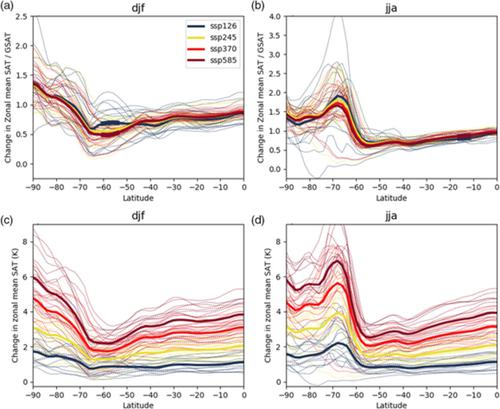当前位置:
X-MOL 学术
›
Atmos. Sci. Lett.
›
论文详情
Our official English website, www.x-mol.net, welcomes your
feedback! (Note: you will need to create a separate account there.)
Twenty first century changes in Antarctic and Southern Ocean surface climate in CMIP6
Atmospheric Science Letters ( IF 2.0 ) Pub Date : 2020-05-28 , DOI: 10.1002/asl.984 Thomas J. Bracegirdle 1 , Gerhard Krinner 2 , Marcos Tonelli 3 , F. Alexander Haumann 4 , Kaitlin A. Naughten 1 , Thomas Rackow 5 , Lettie A. Roach 6 , Ilana Wainer 3
Atmospheric Science Letters ( IF 2.0 ) Pub Date : 2020-05-28 , DOI: 10.1002/asl.984 Thomas J. Bracegirdle 1 , Gerhard Krinner 2 , Marcos Tonelli 3 , F. Alexander Haumann 4 , Kaitlin A. Naughten 1 , Thomas Rackow 5 , Lettie A. Roach 6 , Ilana Wainer 3
Affiliation

|
Two decades into the 21st century there is growing evidence for global impacts of Antarctic and Southern Ocean climate change. Reliable estimates of how the Antarctic climate system would behave under a range of scenarios of future external climate forcing are thus a high priority. Output from new model simulations coordinated as part of the Coupled Model Intercomparison Project Phase 6 (CMIP6) provides an opportunity for a comprehensive analysis of the latest generation of state‐of‐the‐art climate models following a wider range of experiment types and scenarios than previous CMIP phases. Here the main broad‐scale 21st century Antarctic projections provided by the CMIP6 models are shown across four forcing scenarios: SSP1‐2.6, SSP2‐4.5, SSP3‐7.0 and SSP5‐8.5. End‐of‐century Antarctic surface‐air temperature change across these scenarios (relative to 1995–2014) is 1.3, 2.5, 3.7 and 4.8°C. The corresponding proportional precipitation rate changes are 8, 16, 24 and 31%. In addition to these end‐of‐century changes, an assessment of scenario dependence of pathways of absolute and global‐relative 21st century projections is conducted. Potential differences in regional response are of particular relevance to coastal Antarctica, where, for example, ecosystems and ice shelves are highly sensitive to the timing of crossing of key thresholds in both atmospheric and oceanic conditions. Overall, it is found that the projected changes over coastal Antarctica do not scale linearly with global forcing. We identify two factors that appear to contribute: (a) a stronger global‐relative Southern Ocean warming in stabilisation (SSP2‐4.5) and aggressive mitigation (SSP1‐2.6) scenarios as the Southern Ocean continues to warm and (b) projected recovery of Southern Hemisphere stratospheric ozone and its effect on the mid‐latitude westerlies. The major implication is that over coastal Antarctica, the surface warming by 2100 is stronger relative to the global mean surface warming for the low forcing compared to high forcing future scenarios.
中文翻译:

CMIP6在20世纪的南极和南洋表面气候变化
进入21世纪的二十年间,越来越多的证据表明南极和南部海洋气候变化对全球产生了影响。因此,可靠的估算南极气候系统在未来外部气候强迫的一系列情景下的行为方式将成为重中之重。作为耦合模型比对项目第6阶段(CMIP6)的一部分进行协调的新模型模拟的输出,提供了一个机会,可以在广泛的实验类型和情景之外,对最新一代的最新气候模型进行全面分析先前的CMIP阶段。此处,在四个强迫情况下显示了CMIP6模型提供的主要的21世纪南极洲的主要预估:SSP1-2.6,SSP2-4.5,SSP3-7.0和SSP5-8.5。在这些情况下(相对于1995-2014年),世纪末南极地表气温变化为1.3、2.5、3.7和4.8°C。相应的比例降水率变化为8、16、24和31%。除了这些世纪末的变化之外,还对21世纪绝对和全球相对于21世纪预测的路径的情景依赖性进行了评估。区域对策的潜在差异与南极沿海地区特别相关,例如,生态系统和冰架对大气和海洋条件下越过关键阈值的时间高度敏感。总的来说,发现南极沿海地区的预计变化不会随全球强迫线性变化。我们确定了两个可能起作用的因素:(a)随着南大洋继续变暖,全球相对变暖的南大洋在稳定化(SSP2-4.5)和积极减缓(SSP1-2.6)情景中的发展(b)预计南半球平流层臭氧的恢复及其对海洋的影响中纬度西风。主要含义是在南极沿海地区,相对于未来强强迫情景,到2100年,地表变暖相对于低强迫的全球平均地表变暖要强。
更新日期:2020-05-28
中文翻译:

CMIP6在20世纪的南极和南洋表面气候变化
进入21世纪的二十年间,越来越多的证据表明南极和南部海洋气候变化对全球产生了影响。因此,可靠的估算南极气候系统在未来外部气候强迫的一系列情景下的行为方式将成为重中之重。作为耦合模型比对项目第6阶段(CMIP6)的一部分进行协调的新模型模拟的输出,提供了一个机会,可以在广泛的实验类型和情景之外,对最新一代的最新气候模型进行全面分析先前的CMIP阶段。此处,在四个强迫情况下显示了CMIP6模型提供的主要的21世纪南极洲的主要预估:SSP1-2.6,SSP2-4.5,SSP3-7.0和SSP5-8.5。在这些情况下(相对于1995-2014年),世纪末南极地表气温变化为1.3、2.5、3.7和4.8°C。相应的比例降水率变化为8、16、24和31%。除了这些世纪末的变化之外,还对21世纪绝对和全球相对于21世纪预测的路径的情景依赖性进行了评估。区域对策的潜在差异与南极沿海地区特别相关,例如,生态系统和冰架对大气和海洋条件下越过关键阈值的时间高度敏感。总的来说,发现南极沿海地区的预计变化不会随全球强迫线性变化。我们确定了两个可能起作用的因素:(a)随着南大洋继续变暖,全球相对变暖的南大洋在稳定化(SSP2-4.5)和积极减缓(SSP1-2.6)情景中的发展(b)预计南半球平流层臭氧的恢复及其对海洋的影响中纬度西风。主要含义是在南极沿海地区,相对于未来强强迫情景,到2100年,地表变暖相对于低强迫的全球平均地表变暖要强。











































 京公网安备 11010802027423号
京公网安备 11010802027423号